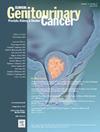Does Size Predict Aggressiveness?: Exploring Sporadic Multifocal Tumors in a 10-Year Retrospective Analysis
IF 2.7
3区 医学
Q3 ONCOLOGY
引用次数: 0
Abstract
Introduction and Objective
For localized kidney tumors, size and growth kinetics generally predict malignant potential. Thus, for patients with multifocal renal masses, treatment priority often revolves around the largest or index tumor first. We reviewed our kidney surgery database to examine histologic concordance of sporadic multifocal renal tumors and to determine if size is also the greatest determinant of tumor aggressiveness.
Methods
We conducted a retrospective chart review at a tertiary referral center of 1983 patients undergoing nephrectomy (radical and partial) from January 2010 to December 2019. We identified 138 patients with multifocal renal masses (n = 138). Surgical pathology parameters, including tumor size, TNM grading, and staging, were collected through electronic medical records. Patients with syndromic diseases were excluded (n = 10), resulting in a total sample of 128 patients with sporadic multifocal tumors. Overall, the sample included 307 tumors total, with a mean number of 2.4 lesions per patient.
Results
About 128 patients (6.45%) had sporadic multifocal renal tumors. Among these, 82 out of 128 (64%) had concordant histologic subtypes, while 46 out of 128 (36%) had discordant histology. In 99 patients (77.3%), the index tumor demonstrated a more aggressive histology. There were 29 patients (22.6%) with a benign or less aggressive index tumor. Among those, 21 patients (16%) had a benign index tumor, 5 (24%) of which had a malignant secondary tumor.
Conclusion
Multifocal tumors frequently have discordant histology. While size tends to predict oncologic risk, many patients harbor more aggressive disease in nonindex lesions, highlighting the limitations of relying on size alone for managing sporadic multifocal RCC.
体型能预测攻击性吗?研究散发性多灶性肿瘤的10年回顾性分析
简介与目的对于局限性肾肿瘤,大小和生长动力学通常预测其恶性潜能。因此,对于多灶性肾肿块患者,治疗优先往往围绕最大或指数肿瘤。我们回顾了我们的肾脏外科数据库,以检查散发性多灶性肾脏肿瘤的组织学一致性,并确定大小是否是肿瘤侵袭性的最大决定因素。方法回顾性分析2010年1月至2019年12月在某三级转诊中心接受肾全切和部分切除的患者1983例。我们确定了138例多灶性肾肿块患者(n = 138)。通过电子病历收集手术病理参数,包括肿瘤大小、TNM分级和分期。排除有综合征性疾病的患者(n = 10),总共128例散发性多灶性肿瘤患者。总体而言,样本共包括307个肿瘤,平均每个患者2.4个病变。结果散发性肾多灶性肿瘤128例(6.45%)。其中,128例中有82例(64%)具有一致的组织学亚型,而128例中有46例(36%)具有不一致的组织学亚型。在99例(77.3%)患者中,指数肿瘤表现为更具侵袭性的组织学。29例(22.6%)为良性或侵袭性指数较低的肿瘤。其中21例(16%)为良性指标肿瘤,5例(24%)为恶性继发肿瘤。结论多灶性肿瘤常具有不一致的组织学特征。虽然大小倾向于预测肿瘤风险,但许多患者在非指数病变中存在更具侵袭性的疾病,这突出了仅依靠大小来管理散发性多灶性RCC的局限性。
本文章由计算机程序翻译,如有差异,请以英文原文为准。
求助全文
约1分钟内获得全文
求助全文
来源期刊

Clinical genitourinary cancer
医学-泌尿学与肾脏学
CiteScore
5.20
自引率
6.20%
发文量
201
审稿时长
54 days
期刊介绍:
Clinical Genitourinary Cancer is a peer-reviewed journal that publishes original articles describing various aspects of clinical and translational research in genitourinary cancers. Clinical Genitourinary Cancer is devoted to articles on detection, diagnosis, prevention, and treatment of genitourinary cancers. The main emphasis is on recent scientific developments in all areas related to genitourinary malignancies. Specific areas of interest include clinical research and mechanistic approaches; drug sensitivity and resistance; gene and antisense therapy; pathology, markers, and prognostic indicators; chemoprevention strategies; multimodality therapy; and integration of various approaches.
 求助内容:
求助内容: 应助结果提醒方式:
应助结果提醒方式:


